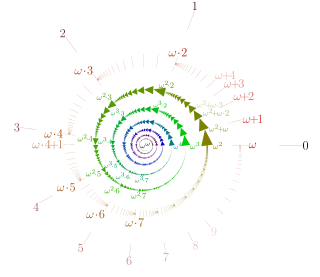
In mathematics, a cardinal number, or cardinal for short, is what is commonly called the number of elements of a set. In the case of a finite set, its cardinal number, or cardinality is therefore a natural number. For dealing with the case of infinite sets, the infinite cardinal numbers have been introduced, which are often denoted with the Hebrew letter (aleph) marked with subscript indicating their rank among the infinite cardinals.
In mathematics, especially in order theory, the cofinality cf(A) of a partially ordered set A is the least of the cardinalities of the cofinal subsets of A.
In mathematics, a topological space is called separable if it contains a countable, dense subset; that is, there exists a sequence of elements of the space such that every nonempty open subset of the space contains at least one element of the sequence.
In mathematics, an uncountable set is an infinite set that contains too many elements to be countable. The uncountability of a set is closely related to its cardinal number: a set is uncountable if its cardinal number is larger than aleph-null, the cardinality of the natural numbers.
In mathematics, an order topology is a certain topology that can be defined on any totally ordered set. It is a natural generalization of the topology of the real numbers to arbitrary totally ordered sets.
In mathematics, a Mahlo cardinal is a certain kind of large cardinal number. Mahlo cardinals were first described by Paul Mahlo. As with all large cardinals, none of these varieties of Mahlo cardinals can be proven to exist by ZFC.
In set theory, a Woodin cardinal is a cardinal number such that for all functions

In mathematics, particularly in set theory, the aleph numbers are a sequence of numbers used to represent the cardinality of infinite sets that can be well-ordered. They were introduced by the mathematician Georg Cantor and are named after the symbol he used to denote them, the Hebrew letter aleph.
In mathematics, a Lindelöf space is a topological space in which every open cover has a countable subcover. The Lindelöf property is a weakening of the more commonly used notion of compactness, which requires the existence of a finite subcover.
In topology, the long line is a topological space somewhat similar to the real line, but in a certain way "longer". It behaves locally just like the real line, but has different large-scale properties. Therefore, it serves as an important counterexample in topology. Intuitively, the usual real-number line consists of a countable number of line segments laid end-to-end, whereas the long line is constructed from an uncountable number of such segments.
In mathematics, limit cardinals are certain cardinal numbers. A cardinal number λ is a weak limit cardinal if λ is neither a successor cardinal nor zero. This means that one cannot "reach" λ from another cardinal by repeated successor operations. These cardinals are sometimes called simply "limit cardinals" when the context is clear.
In set theory, a regular cardinal is a cardinal number that is equal to its own cofinality. More explicitly, this means that is a regular cardinal if and only if every unbounded subset has cardinality . Infinite well-ordered cardinals that are not regular are called singular cardinals. Finite cardinal numbers are typically not called regular or singular.
In set theory, one can define a successor operation on cardinal numbers in a similar way to the successor operation on the ordinal numbers. The cardinal successor coincides with the ordinal successor for finite cardinals, but in the infinite case they diverge because every infinite ordinal and its successor have the same cardinality. Using the von Neumann cardinal assignment and the axiom of choice (AC), this successor operation is easy to define: for a cardinal number κ we have
In mathematics, particularly in set theory, the beth numbers are a certain sequence of infinite cardinal numbers, conventionally written , where is the second Hebrew letter (beth). The beth numbers are related to the aleph numbers, but unless the generalized continuum hypothesis is true, there are numbers indexed by that are not indexed by .
In mathematics, specifically set theory and model theory, a stationary set is a set that is not too small in the sense that it intersects all club sets and is analogous to a set of non-zero measure in measure theory. There are at least three closely related notions of stationary set, depending on whether one is looking at subsets of an ordinal, or subsets of something of given cardinality, or a powerset.
In model theory, a branch of mathematical logic, the spectrum of a theory is given by the number of isomorphism classes of models in various cardinalities. More precisely, for any complete theory T in a language we write I(T, κ) for the number of models of T (up to isomorphism) of cardinality κ. The spectrum problem is to describe the possible behaviors of I(T, κ) as a function of κ. It has been almost completely solved for the case of a countable theory T.
In mathematics, infinitary combinatorics, or combinatorial set theory, is an extension of ideas in combinatorics to infinite sets. Some of the things studied include continuous graphs and trees, extensions of Ramsey's theorem, and Martin's axiom. Recent developments concern combinatorics of the continuum and combinatorics on successors of singular cardinals.
In mathematics, the first uncountable ordinal, traditionally denoted by or sometimes by , is the smallest ordinal number that, considered as a set, is uncountable. It is the supremum of all countable ordinals. When considered as a set, the elements of are the countable ordinals, of which there are uncountably many.

In set theory, an ordinal number, or ordinal, is a generalization of ordinal numerals aimed to extend enumeration to infinite sets.
In mathematics, a polyadic space is a topological space that is the image under a continuous function of a topological power of an Alexandroff one-point compactification of a discrete space.



















